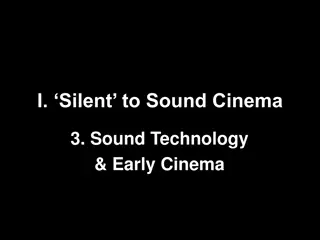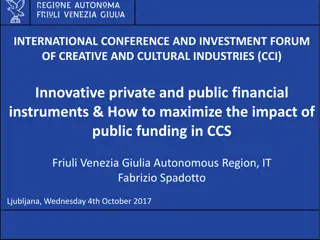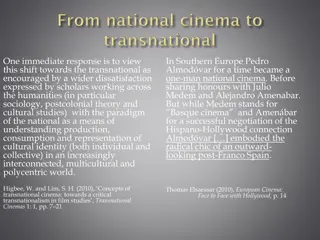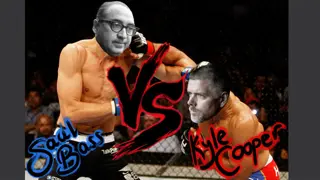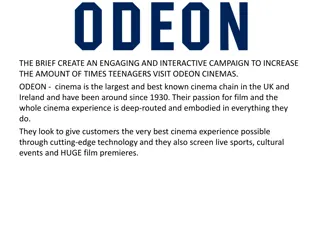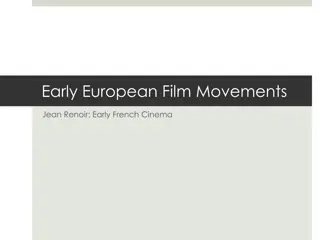Evolution of Motion Pictures: From Early Visual Forms to Modern Cinema
Explore the fascinating history of cinema, tracing back to the 17th and 18th centuries with lantern slides leading to the proliferation of visual forms in the 19th century. Discover how the industrial era ushered in books of photographs and illustrated fiction, catering to the middle and working classes through circuses, amusement parks, and more. Uncover the pre-conditions necessary for the birth of motion pictures and the inventions like the Phenakistoscope and Zoetrope that paved the way for modern cinema. Witness the evolution from hand-held viewers to the revolutionary concept of exposure time in photography, enabling the creation of split-second motion pictures.
Download Presentation

Please find below an Image/Link to download the presentation.
The content on the website is provided AS IS for your information and personal use only. It may not be sold, licensed, or shared on other websites without obtaining consent from the author. Download presentation by click this link. If you encounter any issues during the download, it is possible that the publisher has removed the file from their server.
E N D
Presentation Transcript
History of Cinema From the French, cinematographe meaning motion picture
Early Years 17th-18thcentury: Lantern slides 19thcentury saw vast proliferation of visual forms of popular culture Industrial Era Books of photographs, illustrated fiction
Early Years Middle/working class: Visit circuses, amusement parks, music halls, theater troupes, dioramas, stereoscopes
Diorama Painted backdrops featuring 3-D figures depicting historical events
Stereoscopes Hand-held viewers that created three dimensional effects by using oblong cards with two photographs printed side by side
Pre-conditions for Motion Pictures 1st: Scientists had to realize, the human eye will perceive motion if a series of slightly different images is placed before it in rapid succession- minimally around 16 per second.
Phenakistoscope (1832) Deceiving scope http://www.youtube.com/watch?v=dAoa0mv2id 4
Zoetrope (1833) Life + turn http://www.youtube.com/watch?v=-3yarT_h2ws
Pre-conditions for Motion Pictures 2nd: these fast-moving images needed to be projected on a surface 17thCentury magic lanterns projecting glass lantern slides (paintings illuminated by glass), but couldn t flash large numbers of images fast enough to create illusion of motion.
Pre-conditions for Motion Pictures 3rd: Ability to use photography to make successive pictures on clear surface Speed up exposure time
Exposure the act of presenting rays of light to a photosensitive surface. First photograph/frame had exposure time of 8 hours (1839) Motion pictures=split-second exposure This became feasible in 1878
Pre-conditions for Motion Pictures 4th: Photographs needed to be printed on a base flexible enough to be passed through a camera rapidly. 1888: George Eastman devised a camera that made photographs on rolls of thin paper. Kodak! The next year, he introduced transparent roll of film creating a breakthrough in the move toward cinema.
Pre-conditions of Motion Picture 5th: Needed to find a suitable mechanism for cameras and projectors. The camera: the film strip had to stop briefly while light entered through the lens and exposed each frame; a shutter then covered the film as another frame moved into place.
Shutter a mechanical device for opening and closing the aperture of a camera lens to expose film or the like.
Aperture an opening, usually circular, that limits the quantity of light that can enter an optical instrument.
Major Pre-cursors of Motion Picture Eadward Muybridge (1878) and the running horses Photographer Row of 12 cameras, each making an exposure in one-thousandth of a Second. Lantern to project the images which were eventually drawings copied from the photographs onto a revolving disk See attached video.
Invention of the Motion Picture Thomas Edison developed Kinetoscope in 1891 the first motion picture system (peep show in a box) Scottish-English immigrant William Dixson joined Edison s team to help develop the technology that would combine pictures and sound Looped in :30 vignettes, no story connecting them. Boxing Cats
Kinetoscope A phonograph inside the cabinet. The viewer would look into the peep-holes of the Kinetoscope to watch the motion picture while listening to the accompanying phonograph through two rubber ear tubes connected to the machine. The picture and sound were made somewhat synchronous by connecting the two with a belt 46 frames per second
The Bioscop Invented by Skladanowsky brothers Held two strips of 3 film running side by side- frames projected alternately 15 minute programs Too cumbersome
The Lumiere Brothers Invented a projection system that helped make cinema a commercially viable enterprise internationally!! Designed the cinematographe 35 mm film 16 frames per second
Lumiere Brothers Workers Leaving the Factory, 1895
American Developments Edison s Kinetoscope evolved into Vitascope (life scope) October 1895 Rough Sea at Dover Inventor, Thomas Armat created Vitascope and Edison manufactured it. 1894: American Mutoscope Company 70 mm film that yielded larger, sharper images
American Developments 1897: 2 means of film exhibition Peep show devices for individual viewing Projection systems for audiences Types of cinema: Scenics, topicals and fiction films
Scenics Short travelogues offering views of distant lands
Topicals News events, recreations of key occurrences in studio Sinking of battleship Maine during Spanish-American War (1898)
Fiction Films Brief staged scenes telling a story Some shot outdoors, but most shot in front of painted backdrops 1904-became the industry s main product Camera set up in one position and action unfolded in one continuous take. No credits, music Provided live by the exhibitor
American Developments 1905- Admission to Nickelodeon (movie theater) = $.05-$.10 for a 15-60 minute production Audiences sat on benches, wooden seats Front display=hand painted signs Actors stood behind screen and spoke dialogue in synchronization with the action on the screen Sound effects were made with noisemakers behind the screen Warner Bros., Universal, Paramount, MGM got there start as Nickelodeon exhibitors
American Cinema: Pre WWI Industry professionals focused on swiftly expanding the demand for film in America Nickelodeon theaters were clustered in business districts and working-class neighborhoods 1908 Nickelodeons were the main form of exhibition Most films came from abroad Studio System born from the Nickelodeon boom
American Cinema: Pre-WWI Edison company vs. American Mutoscope and Biograph Conflicts over camera patents and equipment licensing distracted the two companies from the distribution aspect. Two companies decided to cooperate-created Motion Pictures Patent Company that owned and charged licensing fees on key existing patents. Production companies had to pay MPPC licensing fees in order to exist.
Patent An invention or process protected by this right The Vitascope
American Cinema: Pre-WWI MPPC limited number of foreign companies MPPC s goal was to control all three aspects of the industry: production, distribution and exhibition. Only licensed companies could produce, distribute and exhibit films=oligopoly Eastman Kodak only sold films to MPPC licensed companies, etc.
Production The whole creative process involved in the making of a film (shooting footage, set design, costume, directing, editing, etc)
Distribution The process of selling and marketing the film
Exhibition The process of showing the film in theaters Exhibitors were those who owned and operated theaters and were involved in the buying/renting process of films.
Oligopoly When a small number of firms cooperate to control the market. In the film industry, when any other unlicensed firmed attempted to shoot, distribute, or exhibit a film, MPPC would threatened to sue for patent infringement. Monopoly: when one firm controls the market
American Cinema: Pre-WWI The independents fought back!! 6000 theaters agreed to pay the fees to MPPC 2000 refused A market for unlicensed producers and distributors was created by these 2000 This portion of the industry was identified as the independents.
Independents A group of professionals in the film industry who were not licensed through the MPPC to create, distribute, and exhibit films.
American Cinema: Pre WWI The Independent Movement Independent Motion Picture Company, New York Motion Picture Company These companies could rent films from European companies that MPPC had shut out. To avoid patent infringement suits they claimed to be using cameras that employed different mechanisms than Edison s.
American Cinema: Pre-WWI The MPPC retaliated and created the General Film Company in 1910 in an attempt to monopolize the distribution aspect of filmmaking. GFC released ALL films made by MPPC producers. MPPC also hired detectives to investigate the Independents claims in regards to mechanisms. MPPC lost a key suit where IMP claimed to be using a different mechanism and after investigations, the court ruled that this particular mechanism had been anticipated in earlier patents, so therefore was not a violation This freed all independents from the fear of infringement law suits!!!
American Cinema: Pre-WWI After key loss, MPCC suffered, and many independents began banding together. It was during this time that the feature film length was established AND it was the birth of the Hollywood Studio System.











